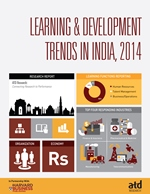ATD Blog
L&D Trends in India: Key Findings from ATD Research
Wed Jan 14 2015

On December 12, 2014, ATD and Harvard Business Publishing’s latest study on learning and development (L&D) trends in India was introduced in front of a group of learning professionals in Bangalore, India, at the ATD India Summit. Vivek Nair, who manages ATD’s operations in India, shared the findings from the 2014 Learning & Development Trends in India report.
The report is ATD’s second investigation of the state of learning in India (the first was published in 2012), and a clearer picture of training activities and spending is beginning to emerge. The number of responding organizations has grown, and their familiarity and comfort with reporting the data has improved.
For the 2014 report, 56 large organizations (on average, responding organizations employ 20,360 people) provided data on their learning activities in India for 2013. Learning professionals should keep in mind that the data covers a wide range of organizations that vary greatly in size, industry, culture, and location.
Learning Hours and Direct Expenditure per Employee
The average number of learning hours used per employee for organizations in India in 2013 was 31. Even though this value represents a downward shift from the inexplicably high 50 hours in the 2012 report, there were fewer reporting organizations that year, and it was the first year the survey was administered. This year’s more realistic value is in line with the data reported in ATD’s State of the Industry Report, which for the past four years has reported that employees receive between 30 and 32 hours of training.
Indian organizations on average spent 13,767 Rupees ($234) per employee on training and development in 2013, also a drop from the last report. Included in this figure are learning and performance staff salaries, travel costs for learning and performance staff, administrative costs, non-salary development costs, delivery costs (such as classroom facilities and online learning technology infrastructure), outsourced activities, and tuition reimbursement.
With fewer hours of training being reported, it is expected that the expenditure would also fall. However, the fact that the number of hours fell more dramatically than spending indicates that organizations are still investing in training and the quality of programs remains strong.
Delivery Methods and Content
Respondents reported on the percentage of their learning programs devoted to 12 common content areas. The top three content areas that accounted for about a third of organizations’ training were profession-specific or industry-specific, managerial or supervisory, and product knowledge. These top three were the same as what was reported in the first iteration of this report back in 2012.
Additionally, respondents were asked to specify how the training was delivered. The traditional instructor-led classroom method continues to be the most popular, accounting for 68 percent of all training delivered in reporting companies.
Commitment to L&D and Looking Ahead
Although the participating organizations represent a very small sample of employers in India, we are optimistic as the findings suggest that large organizations have a strong commitment to L&D.
Also, ATD expects to continue to gather data on L&D in India in 2015 and beyond, as well as establish, build, and strengthen relationships with employers in India. Fortunately, this means that even more trends in L&D in India will likely become evident in the future.
Get the Full Report
The full research report, Learning & Development Trends in India, 2014__, is available for purchase online. Members have complimentary access to the whitepaper version of the report. The infographic is available for everyone.
